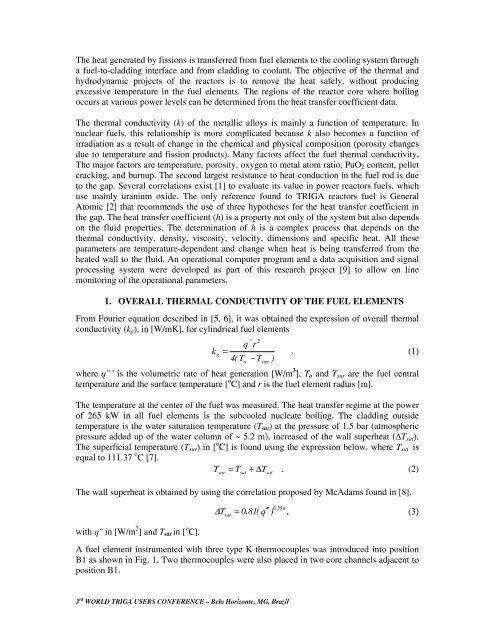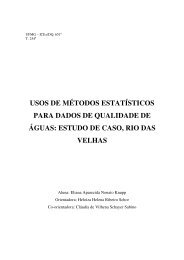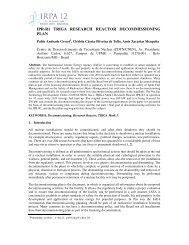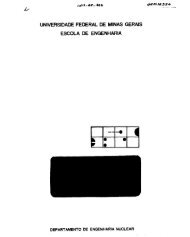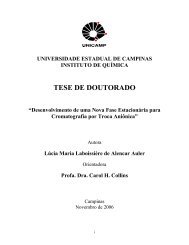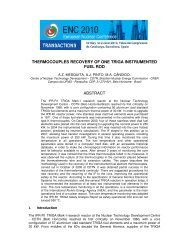experimental heat transfer analysis of the ipr-r1 triga reactor - CDTN
experimental heat transfer analysis of the ipr-r1 triga reactor - CDTN
experimental heat transfer analysis of the ipr-r1 triga reactor - CDTN
- No tags were found...
Create successful ePaper yourself
Turn your PDF publications into a flip-book with our unique Google optimized e-Paper software.
The <strong>heat</strong> generated by fissions is <strong>transfer</strong>red from fuel elements to <strong>the</strong> cooling system througha fuel-to-cladding interface and from cladding to coolant. The objective <strong>of</strong> <strong>the</strong> <strong>the</strong>rmal andhydrodynamic projects <strong>of</strong> <strong>the</strong> <strong>reactor</strong>s is to remove <strong>the</strong> <strong>heat</strong> safely, without producingexcessive temperature in <strong>the</strong> fuel elements. The regions <strong>of</strong> <strong>the</strong> <strong>reactor</strong> core where boilingoccurs at various power levels can be determined from <strong>the</strong> <strong>heat</strong> <strong>transfer</strong> coefficient data.The <strong>the</strong>rmal conductivity (k) <strong>of</strong> <strong>the</strong> metallic alloys is mainly a function <strong>of</strong> temperature. Innuclear fuels, this relationship is more complicated because k also becomes a function <strong>of</strong>irradiation as a result <strong>of</strong> change in <strong>the</strong> chemical and physical composition (porosity changesdue to temperature and fission products). Many factors affect <strong>the</strong> fuel <strong>the</strong>rmal conductivity.The major factors are temperature, porosity, oxygen to metal atom ratio, PuO 2 content, pelletcracking, and burnup. The second largest resistance to <strong>heat</strong> conduction in <strong>the</strong> fuel rod is dueto <strong>the</strong> gap. Several correlations exist [1] to evaluate its value in power <strong>reactor</strong>s fuels, whichuse mainly uranium oxide. The only reference found to TRIGA <strong>reactor</strong>s fuel is GeneralAtomic [2] that recommends <strong>the</strong> use <strong>of</strong> three hypo<strong>the</strong>ses for <strong>the</strong> <strong>heat</strong> <strong>transfer</strong> coefficient in<strong>the</strong> gap. The <strong>heat</strong> <strong>transfer</strong> coefficient (h) is a property not only <strong>of</strong> <strong>the</strong> system but also dependson <strong>the</strong> fluid properties. The determination <strong>of</strong> h is a complex process that depends on <strong>the</strong><strong>the</strong>rmal conductivity, density, viscosity, velocity, dimensions and specific <strong>heat</strong>. All <strong>the</strong>separameters are temperature-dependent and change when <strong>heat</strong> is being <strong>transfer</strong>red from <strong>the</strong><strong>heat</strong>ed wall to <strong>the</strong> fluid. An operational computer program and a data acquisition and signalprocessing system were developed as part <strong>of</strong> this research project [9] to allow on linemonitoring <strong>of</strong> <strong>the</strong> operational parameters.1. OVERALL THERMAL CONDUCTIVITY OF THE FUEL ELEMENTSFrom Fourier equation described in [5, 6], it was obtained <strong>the</strong> expression <strong>of</strong> overall <strong>the</strong>rmalconductivity (k g ), in [W/mK], for cylindrical fuel elementskg''' 2q r= , (1)4(T −T)owhere q”’ is <strong>the</strong> volumetric rate <strong>of</strong> <strong>heat</strong> generation [W/m 3 ], T o and T sur are <strong>the</strong> fuel centraltemperature and <strong>the</strong> surface temperature [ o C] and r is <strong>the</strong> fuel element radius [m].The temperature at <strong>the</strong> center <strong>of</strong> <strong>the</strong> fuel was measured. The <strong>heat</strong> <strong>transfer</strong> regime at <strong>the</strong> power<strong>of</strong> 265 kW in all fuel elements is <strong>the</strong> subcooled nucleate boiling. The cladding outsidetemperature is <strong>the</strong> water saturation temperature (T sat ) at <strong>the</strong> pressure <strong>of</strong> 1.5 bar (atmosphericpressure added up <strong>of</strong> <strong>the</strong> water column <strong>of</strong> ~ 5.2 m), increased <strong>of</strong> <strong>the</strong> wall super<strong>heat</strong> (T sat ).The superficial temperature (T sur ) in [ o C] is found using <strong>the</strong> expression below, where T sat isequal to 111.37 o C [7].T = T + ∆T. (2)sursatThe wall super<strong>heat</strong> is obtained by using <strong>the</strong> correlation proposed by McAdams found in [8],with q" in [W/m 2 ] and T sat in [ o C].sursat∆ T ′′ , (3)0.259sat= 0.81( q )A fuel element instrumented with three type K <strong>the</strong>rmocouples was introduced into positionB1 as shown in Fig. 1. Two <strong>the</strong>rmocouples were also placed in two core channels adjacent toposition B1.3 rd WORLD TRIGA USERS CONFERENCE – Belo Horizonte, MG, Brazil


